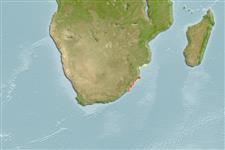>
Blenniiformes (Blennies) >
Blenniidae (Combtooth blennies) > Salariinae
Etymology: Cirripectes: Latin, cirrus = curl fringe + Greek, pektos, -e, -on = made of several parts solidly united (Ref. 45335); heemstraorum: Named for Phil and Elaine Heemstra.
Eponymy: Dr Phillip Clarence Heemstra (1941–2019) was an American/South African marine ichthyologist and scientific diver. [...] (Ref. 128868), visit book page.
Environment: milieu / climate zone / depth range / distribution range
Ecologia
marino associati a barriera corallina; distribuzione batimetrica 1 - 17 m (Ref. 85156). Tropical
Distribuzione
Stati | Aree FAO | Ecosystems | Presenze | Point map | Introduzioni | Faunafri
Western Indian Ocean: Africa.
Size / Peso / Age
Maturity: Lm ? range ? - ? cm
Max length : 4.9 cm SL maschio/sesso non determinato; (Ref. 85156); 7.1 cm SL (female)
Short description
Chiavi di identificazione | Morfologia | Morfometria
Spine dorsali (totale) : 12; Raggi dorsali molli (totale) : 16; Spine anali: 2; Raggi anali molli: 17; Vertebre: 32. This species is distinguished by the following set of characters: nape with greatly expanded black nuchal flap on both sides; 10-13 independently based cirri distributed between the nuchal flaps; dorsal fin entire; 5-6 total supraorbital cirri, 6-8 total nasal cirri; males with small dark spots posteriorly on body coalescing into short black stripes on caudal peduncle; females with brilliant yellow caudal fin (pale when preserved; contrasting sharply with dark brown body); in males the outer half of caudal fin is brilliant yellow (Ref. 85156).
Facultative air-breathing in the genus (Ref. 126274); Oviparous. Eggs are demersal and adhesive (Ref. 205), and are attached to the substrate via a filamentous, adhesive pad or pedestal (Ref. 94114). Larvae are planktonic, often found in shallow, coastal waters (Ref. 94114).
Life cycle and mating behavior
Maturità | Riproduzione | Deposizione | Uova | Fecundity | Larve
Williams, J.T., 2010. A new species of blenny, Cirripectes heemstraorum, from Cape Vidal, South Africa (Family Blenniidae). Smithiana Bull. (12):3-8. (Ref. 85156)
IUCN Red List Status (Ref. 130435: Version 2024-1)
Threat to humans
Harmless
Human uses
Strumenti
Special reports
Download XML
Fonti Internet
Estimates based on models
Preferred temperature (Ref.
123201): 23.6 - 24.6, mean 24.2 °C (based on 16 cells).
Phylogenetic diversity index (Ref.
82804): PD
50 = 0.5000 [Uniqueness, from 0.5 = low to 2.0 = high].
Bayesian length-weight: a=0.01047 (0.00461 - 0.02381), b=2.98 (2.79 - 3.17), in cm total length, based on LWR estimates for this (Sub)family-body shape (Ref.
93245).
Fishing Vulnerability (Ref.
59153): Low vulnerability (10 of 100).
